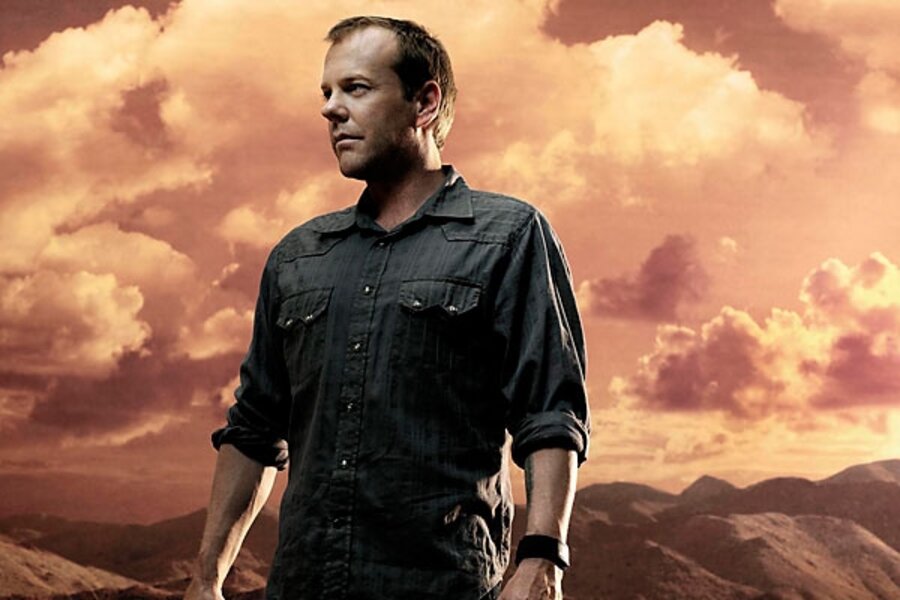Jack Bauer tackles global warming
Loading...
| Chatsworth, Calif.
Fox's political action thriller “24” has long pushed the boundaries of prime-time television with its graphic depictions of violence and torture. Now, the series, in its seventh season, is breaking ground in what may seem an unlikely frontier. Earlier this month, show producers announced that it is the first television program to become “carbon neutral.”
The show reduced its overall carbon emissions to zero through a combination of “better practices,” and the purchase of carbon offsets. “ ‘24’ was a tough choice to start with because of the difficulty in measuring the high number and different types of emissions,” says executive producer Howard Gordon. “But it’s been enormously gratifying because it’s a relatively high- profile show and can influence other shows.”
The impulse grew from a corporate retreat in 2006, at which former Vice President Al Gore addressed the group on his passion project, global warming. Subsequently, Rupert Murdoch, chairman of parent company News Corp., announced his intention to take the entire company carbon neutral by the year 2010.
“We set a modest goal of one episode of ‘24,’ ” says Gary Newman, chairman of 20th Century Fox Television. “But the entire cast and crew embraced it and we succeeded far beyond our expectations.”
Just what this relatively new cultural buzz phrase actually means in the context of a TV drama – routinely defined by its high-octane car crashes, explosions, and fuel – starts with an unexpectedly drab, converted 30,000-square-foot pencil factory on the edge of Los Angeles County.
The soundstage is easy to miss, set in what appears to be just another industrial warehouse section of this L.A. suburb. But this cavernous stage, along with a nearby sister space, has housed “24” since its early days when the action revolved around the fictional Counter Terrorism Unit (CTU) headquarters.
After calling in a head-to-toe assessment from a consulting firm, Clear Carbon, the production team began to make changes to mitigate the eye-popping 2,179 tons of CO2 emissions estimated to be generated by the series. The first item to go was the “ancient fluorescent bulbs” in the old fixtures, says Mike Posey, associate director of production. Roughly 200 fixtures full of four-foot bulbs were replaced with the new, low-impact “cool” CFL bulbs, “the kind you can pick up at Home Depot,” adds Mr. Posey.
Next, the team ticked off a laundry list of items, many of which have begun to crop up as staples of the burgeoning green movement in Hollywood as well as other industries: cut electrical usage, switch to biofuels and recycle, among other actions. The show moved its diesel fuel usage for trucks and generators to include at least 5 percent biofuels.
One of the biggest reductions in carbon emissions came from the simple conversion to digital script delivery. “We used to ferry about 150 scripts around town daily,” says Posey. They also integrated hybrid-fuel vehicles into the production, a tactic that reduced gasoline usage by 1,300 gallons for Season 7 production, which wrapped in December.
One of the most egregious areas, adds Posey with a laugh, was the proliferation of water bottles on sets. “It’s gotten totally out of control,” he says.
Not every aspect of a vast, sprawling Hollywood set can be easily switched to more ecofriendly technology. While he is working on it, Posey points out that the low-impact LED lights favored by environmentalists do not always produce the “density of light that our sets require.”
While such efforts reduced measurable emissions by nearly half, producers turned to carbon offsets to get to a zero-sum equation. These are a portfolio of local and international renewable-energy investments, such as wind and solar farms in the greater Los Angeles area and others in India. And while some shows might be amenable to actually inserting ecofriendly story lines into the narratives, “24” producers point out that their show is not suitable for this tactic. Instead, they have purchased public service announcements, delivered by the show’s stars, such as Kiefer Sutherland and Cherry Jones, during the show’s prime-time slot. In a recent episode, for example, Ms. Jones, who portrays US President Allison Taylor, came on the air at the hour’s midpoint to address the audience about the need to tackle global warming.
Everyone from environmentalists to scientists and media watchdog groups applauds Fox’s long-term commitment to reducing its carbon emissions, but some suggest the hyperbole around the recent “zero-sum” announcement doesn’t help the message. Since absolute carbon neutrality is impossible, points out Allen Hershkowitz, senior scientist at the Natural Resources Defense Council, “we ought to be talking about reductions, not carbon neutrality.” This muddies the waters, he says, because it opens the doors to quibbling over such immeasurables as the impact of forestry practices worldwide.
“Carbon neutrality isn’t usually the place to start a discussion,” says Taylor Grant of the Environmental Media Association, a nonprofit consulting group that works with the entertainment industry on green issues. “In the long run, it’s more useful to talk about the things that people can relate to, such as eliminating water bottles from a set.”
Nonetheless, as animator and industry consultant Jeff Hayes says, Hollywood knows how to tell a story and this is the message of the moment.
“We actually expected more resistance from our crews,” says executive producer Mr. Gordon. After all, as he points out, “a lot of our guys are not granola-crunching ecotypes.”
But after News Corp. “incentivized” its employees with discounts and mileage reimbursements, hybrid cars began to be the norm in the parking lots.
“It’s great to see these teamsters driving around in Priuses,” Gordon says.





